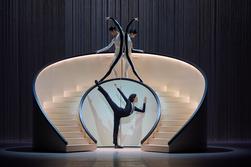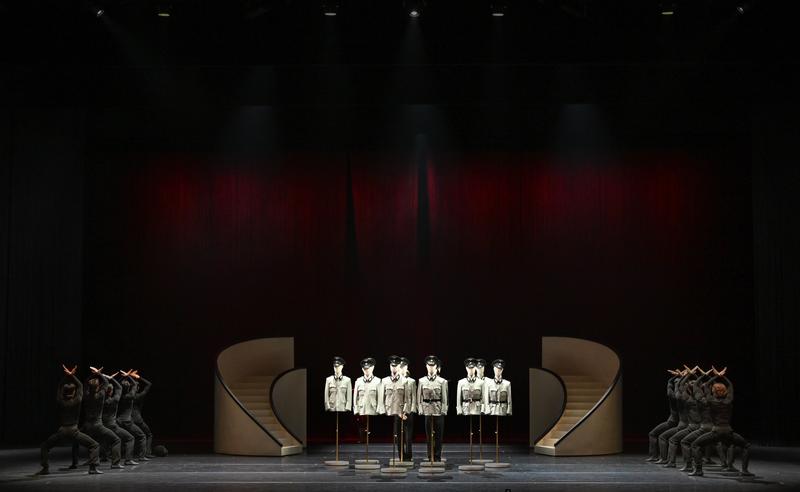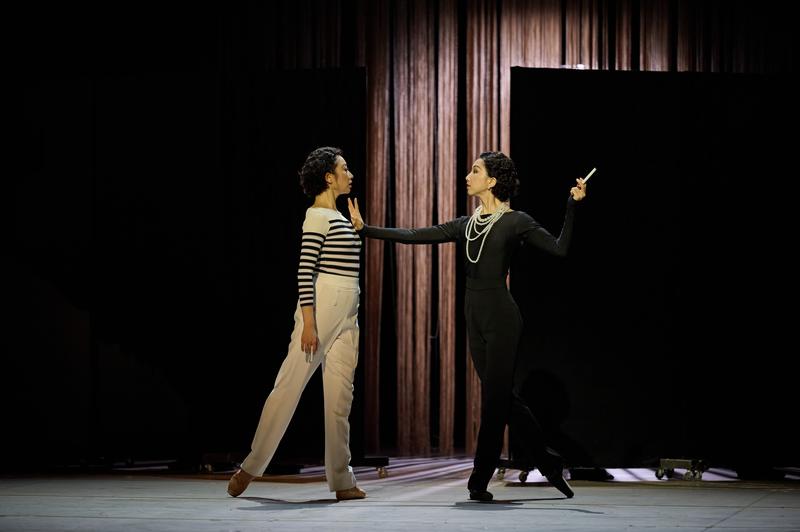 Shadow-Chanel and the logo dancers create gorgeous visuals with the double C-shaped staircase.
Shadow-Chanel and the logo dancers create gorgeous visuals with the double C-shaped staircase.
Perhaps more than anyone, Coco Chanel revolutionized women’s fashion in the early 20th century. While today the French designer’s name is synonymous with luxury and elegance, more than 100 years ago she did away with restrictive corsets and heavy fabrics, empowering women with practical, comfortable, stylish clothing.
A Hong Kong Ballet production exploring the designer’s legacy, Coco Chanel: The Life of a Fashion Icon had its world premiere Mar 24, with five performances (featuring two casts) over the weekend. A collaboration with the Atlanta Ballet and Queensland Ballet, Coco will be performed in Atlanta and Brisbane next year.
Delayed twice by the pandemic, the inaugural show did not disappoint. Coco shares its core creative team with the Dutch National Ballet’s Frida, about the life of artist Frida Kahlo. Annabelle Lopez Ochoa is the choreographer; Nancy Meckler, the dramaturge; Peter Salem composed the original score; and Jerome Kaplan designed the sets and costumes. The music was performed by the Hong Kong Philharmonic Orchestra, under the baton of Faycal Karoui.
 The 1940 Nazi invasion of Paris is represented on stage by the arrival of mannequins resembling German officers.
The 1940 Nazi invasion of Paris is represented on stage by the arrival of mannequins resembling German officers.
READ MORE: Chanel: Iconic couturier Karl Lagerfeld has died
Salem’s score is wonderfully modern and atmospheric, while Billy Chan’s elegantly sparse yet inventive lighting design achieved the difficult task of suggesting environments ranging from Belle Epoque Paris salons to the city’s streets at the moment of the 1940 Nazi invasion.
Kaplan masterfully imbued the set design with the brand’s aesthetics, taking an intelligently minimalist approach. Ateliers, boutiques, lavish parties and occupied Paris were conjured with little more than two staircases, mannequins, and some tables and chairs.
The double curved staircase beautifully represented the Chanel logo as well as the designer’s ascent on the world stage. Seamstresses’ work chairs levitated to reveal their glowing underside, effectively becoming chandeliers, while the famous Chanel camellia was a recurring light fixture. When the Nazis arrived to occupy Paris, mannequins resembling officers and searchlights hitting the audience were used to dramatic effect.
 A commanding Shadow-Chanel interacts with the real-life Chanel, wearing her iconic sailor suit.
A commanding Shadow-Chanel interacts with the real-life Chanel, wearing her iconic sailor suit.
In every scene, Chanel is observed by or interacts with the self-actualized version of herself: Shadow-Chanel, dressed in the designer’s trademark little black dress and strings of pearls, complete with a cigarette holder. The Shadow injects a degree of interiority into the protagonist’s story, helping to illustrate her private struggles. Directing all Chanel’s decisions, the Shadow represents the designer’s drive and determination to succeed.
Several themes emerge — the first being Chanel’s metamorphosis into a fashion and entrepreneurial powerhouse. Second is her transformation of women’s clothing. In the final scene, Chanel and her Shadow uncover the designer’s simple silhouettes by stripping every woman on stage of their Christian Dior dress — Chanel viewing Dior’s popular Nouvelle Vague fashion as excessive and ostentatious.
READ MORE: An iconic performance
 Coco Chanel does a deal making Pierre Wertheimer (red suit) fully responsible for the production, marketing and distribution of her No. 5 perfume. The Chanel camellia light fixtures are visible through the curtain.
Coco Chanel does a deal making Pierre Wertheimer (red suit) fully responsible for the production, marketing and distribution of her No. 5 perfume. The Chanel camellia light fixtures are visible through the curtain.
Finally, there are the designer’s colorful relationships — her multiple love affairs, including with a Nazi officer; and her dealings with the business partner she grew to resent, and sought to double-cross by invoking a Nazi-era law that would strip the Jewish Pierre Wertheimer of the Chanel perfume business. (This ploy failed when it turned out Wertheimer had judiciously parked the business with a gentile friend.)
Chanel’s triumphal return to the global fashion stage — following her Swiss exile to escape retribution — is a final scene that, with its seamstresses and mannequins, echoes the beginning of Act I to bring us full circle. In terms of the dancing, highlights included a touching duet between Chanel and her great love, Boy Capel; and a fluid, mesmerizing duet in which the costumes — full-length, white unitards with black stripes down the sides — stood for the Chanel logo. The entire ballet company did a masterful job, with magnificent performances from Yang Ruiqi in the title role as well as the other principals.
 A lovers' pas de deux: Chanel and Boy Capel. It has been speculated that the interlocking-C's logo actually stands for Chanel and Capel.
A lovers' pas de deux: Chanel and Boy Capel. It has been speculated that the interlocking-C's logo actually stands for Chanel and Capel.
Presenting the life of a fashion icon who was also a Nazi collaborator is an interesting assignment. Lopez Ochoa and Meckler have chosen to gloss over the subject somewhat — for Chanel was not just sleeping with the enemy: she was a spy and informant in the service of the Third Reich. In omitting Chanel’s active collaboration with the Nazis, Coco’s creators have lost the opportunity to pursue a narrative line that would have lent real dramatic tension to the story. Their priority, evidently, was to produce the most beautiful visuals — and they have certainly succeeded at that. A fitting result, perhaps, as the idea was to represent the world of high fashion, including its foibles.


